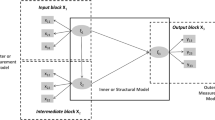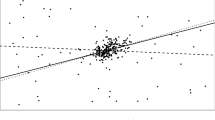Abstract
In very many applications and, in particular, in PLS path modeling, it is of paramount importance to assess whether a set of variables is unidimensional. For this purpose, different methods are discussed. In addition to methods generally used in PLS path modeling, methods for the determination of the number of components in principal components analysis are considered. Two original methods based on permutation procedures are also proposed. The methods are compared to each others by means of a simulation study.
Access this chapter
Tax calculation will be finalised at checkout
Purchases are for personal use only
Preview
Unable to display preview. Download preview PDF.
Similar content being viewed by others
References
BARTLETT, M.S. (1950): Tests of Significance in Factor Analysis. British Journal of Psychology (Statistical Section), 3, 77–85.
CRONBACH, L.J. (1951): Coefficient Alpha and the Internal Structure of Tests. Psychometrika, 16, 297–334.
DILLON, W.R., and GOLDSTEIN, M. (1984): Multivariate Analysis. Methods and Applications. John Wiley and Sons, New York.
HATTIE, J. (1985): Methodology Review: Assessing Unidimensionality of Tests and Items. Applied Psychological Measurement, 9, 139–164.
JACKSON, J.E. (1991): A User’s Guide to Principal Components. John Wiley and Sons, New York.
KAISER, H.F. (1992): On Cliff’s Formula, the Kaiser-Guttman Rule, and the Number of Factors. Perceptual and Motor Skills, 74, 595–598.
KARLIS, D., SAPORTA, G., and SPINAKIS, A. (2003): A simple Rule for the Selection of Principal Components. Communications in Statistics. Theory and Methods, 32, 643–666.
KRZANOWSKI, W.J., and KLINE, P. (1995): Cross-Validation for Choosing the Number of Important Components in Principal Component Analysis. Multivariate Behavioral Research, 30, 149–165.
PERES-NETO, P.R., JACKSON, D.A., and SOMERS, K.M. (2005): How many principal components? stopping rules for determining the number of non-trivial axes revisited. Computational Statistics and Data Analysis, 49, 974–997.
SAS/STAT (1999): User’s guide, Version 8, SAS Institute Inc.: Cary, North Carolina.
TENENHAUS, M., VINZI, V.E., CHATELIN, Y.-M. and LAURO, C. (2005): PLS path modeling. Computational Statistics and Data Analysis, 48, 159–205.
VIGNEAU, E., and QANNARI, E.M. (2003): Clustering of Variables around Latent Components. Communications in Statistics — Simulation and Computation, 32, 1131–1150.
Author information
Authors and Affiliations
Editor information
Editors and Affiliations
Rights and permissions
Copyright information
© 2006 Springer Berlin · Heidelberg
About this paper
Cite this paper
Sahmer, K., Hanafi, M., El Qannari, M. (2006). Assessing Unidimensionality within PLS Path Modeling Framework. In: Spiliopoulou, M., Kruse, R., Borgelt, C., Nürnberger, A., Gaul, W. (eds) From Data and Information Analysis to Knowledge Engineering. Studies in Classification, Data Analysis, and Knowledge Organization. Springer, Berlin, Heidelberg. https://doi.org/10.1007/3-540-31314-1_26
Download citation
DOI: https://doi.org/10.1007/3-540-31314-1_26
Publisher Name: Springer, Berlin, Heidelberg
Print ISBN: 978-3-540-31313-7
Online ISBN: 978-3-540-31314-4
eBook Packages: Mathematics and StatisticsMathematics and Statistics (R0)




